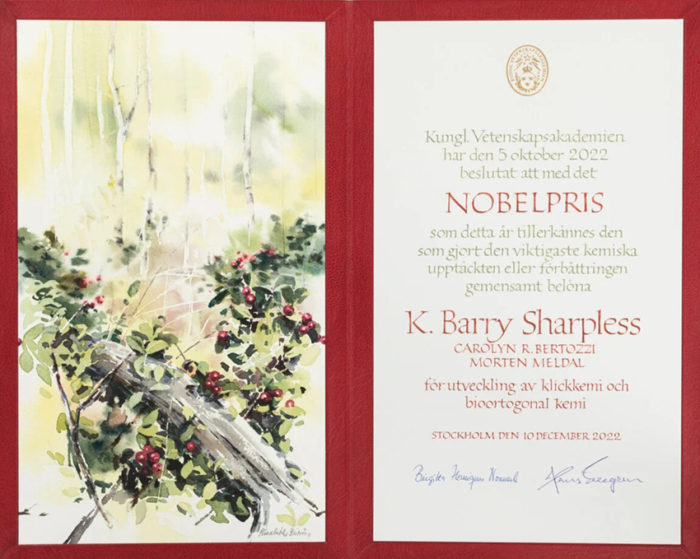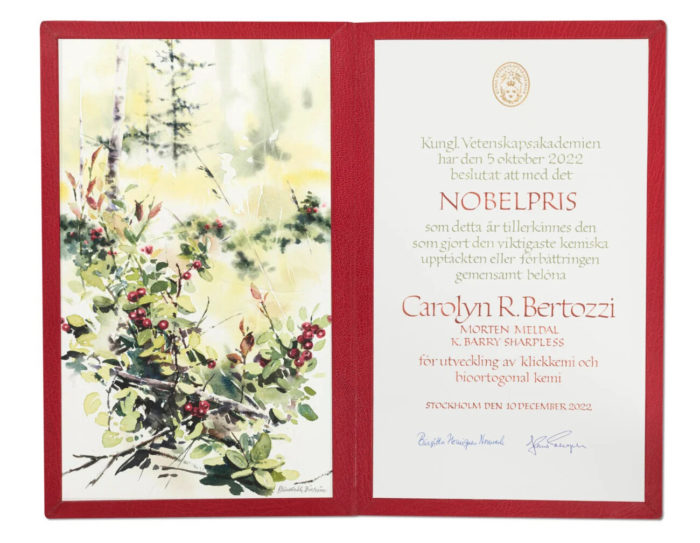Jag läser att Nobelkonditor Annie Hesselstad har beställt 50 kilo lingon till desserten som konungen och de andra gästerna på kvällens bankett ska få avnjuta. Vilket fint val.

Lingonet är det vanligaste, viktigaste och mest delikata av våra bär. Det passar till allt: köttet, gröten, palten. Sött eller salt går lika bra – det syrliga lingonet står rakryggad alla sällskap.
Lingonet är höstens tröst. När den korta sommaren har passerat kan man åtminstone glädjas åt att frysen snart kan fyllas med sylten.
Lingonet är inte insmickrande, men en upplevelse. Allra godast är det på vårvintern, när en tuva har tinat fram och man hittar några solljumna juveler till vattlingon. Har du smakat dem? Innanmätet förvandlas långsamt under snötäcket till ren saft, sötsyrlig. Det går att göra dem i kylskåpet också: det behövs bara lingon och vatten, så omdanar och konserverar de sig själva. Men de smakar inte vårvintersol, förstås.
Jag målade lingon i fjolårets diplom till kemipristagarna Carolyn Bertozzi, Morten Meldal och Barry Sharpless. Dels passade de så fint till det röda skinn som Nobelpriset i kemi alltid omsluts av. Dels ville jag skicka med en liten bit av Sverige, till minne av dagarna här. För det tredje passade motivet till målningarna jag ville göra, där jag komponerade bilderna så att de kunde sammanfogas i vilka kombinationer som helst och bli till en ny helhet – en blinkning till den klickkemi som priset gällde.

Jag plockade många kilo lingon som barn, för jag växte upp i norra Västerbotten. Lingonlandet. Mitt tidigaste plockarminne är från fyra-, femårsåldern. Jag och pappa var i skogen. Plötsligt viskade han åt mig att sätta mig ner. Vi hukade och höll andan, medan en älgtjur spatserade förbi, alldeles intill. Han var väl också lingonsugen, kan jag tro. Även skogens konung vill ha sin Nobeldessert.
Food for kings
I read that the Nobel pastry chef Annie Hesselstad has ordered 50 kilos of lingonberries for the dessert that the king and the other guests at tonight’s banquet will enjoy. What a fine choice.
The lingonberry is the most common, most important and most delicious of our Swedish berries. It goes with everything: the meat, the oatmeal, the traditional palt (a dish consisting of a ball of dough, with salted pork in the middle, boiled, and served with butter and lingonberry jam). Sweet or savoury food – the tart lingonberry stands it’s ground in any company.
The lingonberry is a consolation when fall comes upon us. While it’s hard to face that the short summer has already passed by, you can at least be happy that the freezer will soon be filled with jam.
The lingonberry is not ingratiating, but it is always a taste experience. It’s at it’s best in the spring-winter, when a tuft has thawed and you find a few jewel-like watery lingonberries. Have you tasted them? Under the snow cover the inside of the berries slowly turns into pure juice, sweet and tart. You can make them in the fridge too: all you need is lingonberries and water, and they transform and preserve themselves. But they don’t taste like the spring-winter sun, of course.
I painted lingonberries in last year’s diplomas for the chemistry prize laureates Carolyn Bertozzi, Morten Meldal and Barry Sharpless. I chose lingonberries because they suited the red leather cover that the Nobel Prize in Chemistry is wrapped in, and beacuse I wanted to send the laureates a small piece of Sweden as a memory of the days here during Nobel week. And last but not least, I made a connection between the scientific findings that the laureates’ recieved their price for, and my paintings. I composed the three watercolors so they could be joined in any combination to form a whole image, as a nod to click chemistry. Only instead of molecules: lingonberries.

I picked lots of lingonberries as a child, because I grew up in northern Sweden, in Västerbotten. Lingonberry land. My earliest memory of picking them is from the age of four or five. My father and I were out in the woods. Suddenly he whispered to me to sit down. As we sat there, holding our breaths, a moose bull strolled by us. Perhaps he also had a craving for lingonberries. The king of the forest wants his Nobel desert too.
Images:
Artist: Elisabeth Biström | Calligrapher: Marianne Pettersson Soold | Book binder: Leonard Gustafssons Bokbinderi AB | Photo reproduction: Lovisa Engblom | © The Nobel Foundation 2022
